Overview of species and varieties of buzulnik

Buzulnik is a perennial herb belonging to the Aster family. It can be found quite often in summer cottages, as well as in parks, gardens and other areas. This plant is preferred by novice gardeners, since the process of caring for it does not require much effort. In addition, by its nature, a given crop is a group of plants that is diverse and includes many species and varieties. In the article, we will give the classifications of the buzulnik, we will list its most common varieties, and also talk about the options for use in landscape design.




Overview of the main groups by the shape of the inflorescences
Buzulnik, from a botanical point of view, is a herb that is great for outdoor use. If you try to classify its representatives, then you can use such an indicator as the shape of the inflorescences. There are three most popular subgroups. Let's consider each of them in more detail.




With corymbose
A typical representative of the described plant, which has corymbose inflorescences, is a toothed buzulnik. It is rather large in size and can grow up to 1 meter.
The most common and widely used varieties of this group include:
- Britt Marie Crawford ("Britt Marie Crawford");
- Desdemona ("Desdemona");
- Othello ("Othello");
- Osiris Fantasy (Osiris Fantasy).




Toothed buzulnik can become an adornment of any garden plot, as it goes well with any other flowering crops.
As for leaving, experienced experts advise covering it for the winter. Despite the fact that the plant tolerates cold quite well, preventive measures will not be superfluous.
Buzulnik toothed blooms in the summer-autumn period. Moreover, its flowers are colored in light brown and yellow tones.




With spicate
The category of this culture with a spike-shaped inflorescence is represented by 3 types:
- Buzulnik Przewalski;
- narrow-headed;
- Siberian.
If in a garden or on a public territory you saw a growing buzulnik, then most likely this flower will be a Przewalski's buzulnik. This type is considered one of the most common.



In terms of care and planting, this plant is undemanding, and therefore it is planted quite often in the far corners of the garden or vegetable garden, on the banks of ponds, as well as in large mixborders. Representatives of this species attract with their appearance, in particular, the yellow color of the inflorescences, which, in turn, consist of cut petals. At the same time, the total height of the plant can reach one and a half meters, practically catching up with human growth. It should be borne in mind that the flowering period of Przewalski's buzulnik falls on the end of June.


The next numerous representative of this category is the narrow-headed buzulnik. The characteristic features of this plant can be considered quite strong stems, as well as high growth. The leaves of the plant have a triangular shape with a jagged edge. It is important to note that their colors change depending on the season. So, in the spring, the foliage of the narrow-headed Buzulnik is painted in a rich green hue, and in the fall it can acquire a purple color.

Siberian buzulnik, the third representative of the class of plants with spike-shaped inflorescences, is a perennial plant.The flower has a short rhizome and an erect stem. In terms of its height, the Siberian species can reach 1.2 meters. The shape of the leaves is triangular-heart-shaped, which makes the plant stand out among its fellows. The leaves have teeth at the edges, and pubescence at the bottom. The flowering period of the plant occurs in the first summer months. In this case, the flowers are painted in bright yellow shades.

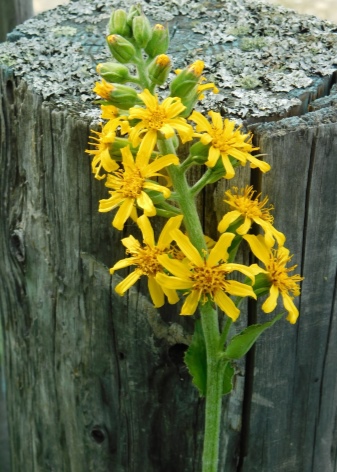
With pyramidal
Another group of buzulniks consists of plants that have a pyramidal shape of inflorescences. These flowers include:
- Fisher's Buzulnik;
- gray type;
- Buzulnik Vich.



Let's talk about each type in more detail
If you describe Fisher's Buzulnik, it should be noted that the height of the plant is a rather variable indicator, since it can vary from 30 to 150 cm. Plants of this variety have a rather short root system and grooved shoots.
The leaf plates of Fisher's buzulnik are heart-shaped or lance-shaped. Moreover, their length can reach 23 cm, and the width - 25 cm. The upper part of the leaf can be either rounded or pointed. The flowers of the plant are painted in a rich yellow hue. The diameter of the inflorescences can be up to 0.4 cm.

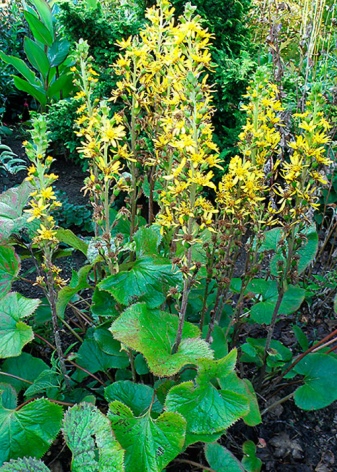
Gray buzulnik (second name - zhivulka) by its biological characteristics is a perennial plant. It is very popular not only among gardeners, but also among fans of traditional medicine - the plant has medicinal and life-giving properties. From a botanical point of view, the zivulka belongs to the Asteraceae family.
The rhizome of this plant is rather thin in structure, has a creeping shape, as well as small adventitious roots. The stem is colored red and has a ribbed texture. In height, it can grow up to 1.5 m. The flowering time of the plant falls in late spring - early summer. It is important to note that the flowers form baskets and are colored in a rich yellow hue. Gray Buzulnik is grown in the local area, but it can also be found in the wild. The area of the plant is Siberia.

If we talk about the medicinal and medicinal properties of zhivulka, it is important to note that it helps to heal wounds, and also has an anti-inflammatory effect. Water solutions of blue-gray buzulnik have soothing properties.
Buzulnik Vicha also has a pyramidal type of inflorescences. Its height is 2 meters, thus the plant exceeds human growth. Buzulnik Vicha belongs to the category of perennial plants. The leaves are heart-shaped and can be up to 40 cm long. The flowering time is in August. It should also be noted that the plant is characterized by increased winter hardiness.

Other popular types
In addition to the above-described types of buzulnik, botanists distinguish other varieties of this culture. There are wild, hybrid, narrow-leaved and other types. Let's consider them in more detail.

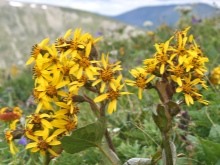

Palm-shaped
The second name of this species is finger-lobed. This plant is a perennial. As for its size, it should be noted that the diameter of the buzulnik can reach 0.9 meters, and the height - 1.8 m.
The flowering period begins in July and lasts about a month. It should be borne in mind that for full growth and development, the plant needs a suitable soil - it must be loose in its structure and fertile in its properties.
Representatives of the palm-shaped species of buzulnik tolerate shade and low temperatures well.


Slope
Slope Buzulnik is the second name for the toothed type of plant. The homeland of this variety are countries such as Japan and China. The plant can reach a height of 100 cm.
Quite often, this type of buzulnik is used in landscape design. It can be grown as single plantings or used as part of flower arrangements.

Tangut
The main difference between this type of plant and any others is the tuberous root. This type of buzulnik is highly resistant, so it can grow even in heavy soils (for example, in clay soil). The plant can reach a height of 90 cm.
The leaves of Buzulnik Tangut have an openwork shape, and the flowers are rather small in size and are painted in golden tones.

Wilson
The homeland of this type of buzulnik is Central China. At the same time, the plant began to be domesticated since 1900. The Wilson Buzulnik has a straight stem that is capable of branching. Its height is 150 cm.
The flowering period is 1-1.5 months and falls in July, early August. The inflorescences of the plant are collected in yellow baskets, the size of which is not more than 2.5 cm. Differs in increased winter hardiness. Nevertheless, it needs mulching and shelter for the winter.

Most popular varieties
Consider a description of several more varieties of buzulnik that have become popular with gardeners.
Pandora
"Pandora" is a miniature plant variety, its height does not exceed 35 cm. At the same time, the flower has serrated leaves, which are painted in a dark purple tone. The flowers are bright orange. It is possible to land the Pandora in the shade.


Little rocket
Outwardly, this variety is a rather lush bush with strong and smooth stems. Its height can reach 90 cm. The leaves are colored green and grow up to 20 cm long. The flowers are rather small, they form inflorescences in the form of baskets. The plant has a pleasant aroma, as well as a long flowering period, and therefore fell in love with gardeners.

Rocket
The plant has dark green leaves up to 20 cm long. The variety is a good honey plant. The flowers of the "Rocket" are painted in the traditional yellow color.

Confetti garden
The main color of the leaves of this variety is traditionally green. However, it is important to note the fact that you can often see small inclusions of a creamy shade on the leaves. The petioles are colored red. The variety should be planted on moist and fertile soil, but it can also grow on heavier soils (for example, clay).

Granito
It is a hybrid variety that is intended for planting curbs, as well as for decorating garden paths and flower beds. "Granito" belongs to the category of dwarf and ornamental plants. The leaves of "Granito" are considered especially beautiful: although the background shade is pale green, you may also notice unique marble-like stains on its surface. The height of the variety does not exceed 0.6 m.

Cafe noir
It has leaves of a triangular shape and reaches a height of 60 cm. The flowers are painted in golden shades and in their appearance resemble chamomile. The aroma of the flower also makes a pleasant impression.

Brit Marie
This variety is completely decorative. It has rounded chocolate-colored leaves, and the plant blooms in July.

Gregenog gold
Prefers wet and shaded areas. It reaches a height of 150 cm.

Dark beauty
The maximum height is 100 cm. At the same time, there are rather large leaves that form a basal rosette. The flowers of the plant can have several shades from bright yellow to light brown. The flowering period is about 30 days and begins in August. Has high winter hardiness properties.
Buzulnik is an unusual plant that includes a variety of species and varieties that differ not only in appearance, but also in the method of cultivation, winter hardiness and other characteristics.
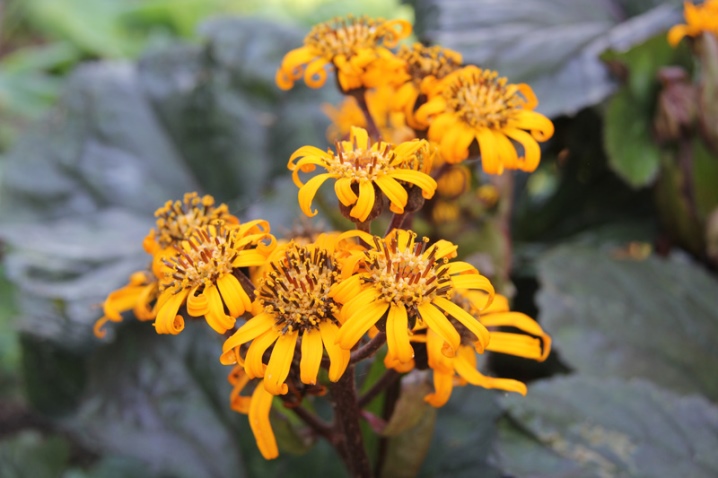
Examples in landscape design
Buzulnik of any type and variety is quite actively used in landscape design. At the same time, with its help, both single plantings and compositions can be created in combination with such plants as daylily, snake mountaineer, hosta, cuff and many others.At the same time, it is important to correctly select the color scheme of additional plants so that they are harmoniously combined or set off the bright yellow color of the buzulnik.
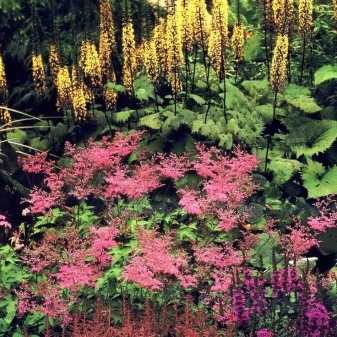

It can be planted both in individual garden plots and in public areas, decorate flower beds with it, create slides and rock gardens, plant around gazebos or along footpaths, near entrances.


Planting and leaving the buzulnik in the video below.







































































































The comment was sent successfully.